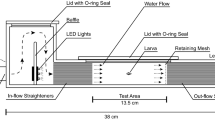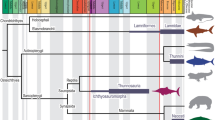Abstract
The Labridae is an ecologically diverse group of mostly reef associated marine fishes that swim primarily by oscillating their pectoral fins. To generate locomotor thrust, labrids employ the paired pectoral fins in motions that range from a fore-aft rowing stroke to a dorso-ventral flapping stroke. Species that emphasize one or the other behavior are expected to benefit from alternative fin shapes that maximize performance of their primary swimming behavior. We document the diversity of pectoral fin shape in 143 species of labrids from the Great Barrier Reef and the Caribbean. Pectoral fin aspect ratio ranged among species from 1.12 to 4.48 and showed a distribution with two peaks at about 2.0 and 3.0. Higher aspect ratio fins typically had a relatively long leading edge and were narrower distally. Body mass only explained 3% of the variation in fin aspect ratio in spite of four orders of magnitude range and an expectation that the advantages of high aspect ratio fins and flapping motion are greatest at large body sizes. Aspect ratio was correlated with the angle of attachment of the fin on the body (r = 0.65), indicating that the orientation of the pectoral girdle is rotated in high aspect ratio species to enable them to move their fin in a flapping motion. Field measures of routine swimming speed were made in 43 species from the Great Barrier Reef. Multiple regression revealed that fin aspect ratio explained 52% of the variation in size-corrected swimming speed, but the angle of attachment of the pectoral fin only explained an additional 2%. Labrid locomotor diversity appears to be related to a trade-off between efficiency of fast swimming and maneuverability in slow swimming species. Slow swimmers typically swim closer to the reef while fast swimmers dominate the water column and shallow, high-flow habitats. Planktivory was the most common trophic associate with high aspect ratio fins and fast swimming, apparently evolving six times.
Similar content being viewed by others
References cited
Baudinette, R.V. & P. Gill. 1985. The energetics of ‘flying’ and ‘paddling’ in water: locomotion in penguins and ducks. J. Comp. Physiol. B155: 373–380.
Bellwood, D.R. 1994. A phylogenetic study of the parrotfishes family Scaridae (Pisces: Labroidei), with a revision of genera. Rec. Aust. Mus. Suppl. No. 20: 1–84.
Bellwood, D.R. 1995a. Direct estimate of bioerosion by two parrotfish species Chlorurus gibbus and Chlorurus sordidus on the Great Barrier Reef. Mar. Biol. 121: 419–430.
Bellwood, D.R. 1995b. Carbonate transport and intrareefal patterns of bioerosion and sediment release by parrotfishes (family Scaridae) on the Great Barrier Reef. Mar. Ecol. Prog. Ser. 117: 127–136.
Bellwood, D.R. 1996. Production and reworking of sediment by parrotfishes (family Scaridae), on the Great Barrier Reef, Aust. Mar. Biol. 125: 795–800.
Bellwood, D.R. & J. H. Choat. 1990. A functional analysis of grazing in parrotfishes (family Scaridae): the ecological implications. Env. Biol. Fish. 28: 189–214.
Bellwood, D.R. & P.C. Wainwright. 2001. Swimming ability in labrid fishes: implications for habitat use and cross-shelf distribution on the Great Barrier Reef. Coral Reefs 20: 139–150.
Bernardi, G., D.R. Robertson, D.R., K. E. Clifton & E. Azzurro. 2000. Molecular systematics, zoogeography, and evolutionary ecology of the Atlantic parrotfish genus Sparisoma. Mol. Phylogen. Evol. 15: 292–300.
Blake, R.W. 1979. The mechanics of labriform locomotion I. Labriform locomotion in the angelfish (Pterophyllum eimekei): an analysis of the power stroke. J. Exp. Biol. 82: 255–271.
Blake, R.W. 1981. Influence of pectoral fin shape on thrust and drag in labriform locomotion. J. Zool., Lond. 194: 53–66.
Choat, J.H. 1991. The biology of herbivorous fishes on coral reefs. pp. 120–155. In: P.F. Sale (ed.) The Ecology of Fishes on Coral Reefs, Academic Press, San Diego.
Daniel, T.L. 1988. Forward flapping flight from flexible fins. Can. J. Zool. 66: 630–638.
Darlington, R.B. 1990. Multiple regression and linear models. McGraw-Hill, New York. 213 pp.
Davenport, J., S.A. Munks & P.J. Oxford. 1984. A comparison of the swimming of marine and freshwater turtles. Proc. R. Soc. Lond. B220: 447–475.
Drucker, E.G. & G.V. Lauder 1999b. Locomotor forces on a swimming fish: three-dimensional vortex wake dynamics quantified using digital particle image velocimetry. J. Exp. Biol. 202: 2393–2412.
Fish, F.E. 1992. Aquatic locomotion. pp. 34–63. In: T.E. Tomasi & T.H. Horton (ed.) Mammalian Energetics: interdisciplinary Views of Metabolism and Reproduction, Cornell University Press, Ithaca.
Fish, F.E. 1996. Transitions from drag-based to lift-based propulsion in mammalian swimming. Amer. Zool. 36: 628–641.
Fulton, C.J. & D.R. Bellwood. 2002. Ontogenetic habitat use in labrid fishes: an ecomorphological perspective. Mar. Ecol. Prog. Ser. 266: 135–142.
Fulton, C.J., D.R. Bellwood & P.C. Wainwright. 2001. The relationship between swimming ability and habitat use in wrasses (family Labridae). Mar. Biol. 139: 25–33.
Gomon, M.F. 1997. Relationships of fishes of the labrid tribe Hypsigenyini. Bull. Mar. Sci. 60: 789–871.
Hobson, E.S. 1974. Feeding relationships of teleost fishes on coral reefs in Kona, Hawaii. U.S. Fish. Bull. 72: 915–1031.
Hobson, E.S. & J.R. Chess. 1978. Trophic relationships among fishes and plankton in the lagoon at Enewetak Atoll, Marshall Islands. U.S. Fish. Bull. 76: 133–153.
James, F.C. & C.E. McCulloch. 1990. Multivariate-analysis in ecology and systematics – panacea or Pandora's box. Ann. Rev. Ecol. Syst. 21: 129–166.
McGehee, M.A. 1994. Correspondence between assemblages of coral reef fishes and gradients of water motion, depth and substrate size off Puerto Rico. Mar. Ecol. Prog. Ser. 105: 243–255.
Pedzazur, E.J. 1982. Multiple regression in behavioral research, 2nd ed. Harcourt Brace, Fort Worth. 367 pp.
Randall, J.E. 1967. Food habits of reef fishes of the West Indies. Stud. Trop. Oceanogr. 5: 655–847.
Randall, J.E. 1983. Caribbean reef fishes. T.F.H., Neptune City. 350 pp.
Randall, J.E., G.E. Allen & R.C. Steene. 1997. Fishes of the Great Barrier Reef and Coral Sea. Crawford House Publishers, Bathurt. 557 pp.
Russell, B.C. & J. E. Randall. 1980. The labrid fish genus Pseudolabrus from islands of the southeastern Pacific, with description of a new species from Rapa. Pac. Sci. 34: 433–443.
Thom, A. & P. Swart. 1940. The forces on an aerofoil at very low speeds. J. Roy. Aero. Soc. 44: 761–770.
Vogel, S. 1994. Life inmoving fluids, 2nd ed. Princeton University Press, Princeton. 467 pp.
Wainwright, P.C. 1988. Morphology and ecology: the functional basis of feeding constraints in Caribbean labrid fishes. Ecology 69: 635–645.
Walker, J.A. & M.W. Westneat. 1997. Labriform propulsion in fishes: kinematics of flapping aquatic flight in the bird wrasse Gomphosus varius (Labridae) J. Exp. Biol. 200: 1549–1569.
Walker, J.A. & M.W. Westneat. 2000. Mechanical performance of aquatic rowing and flying. Trans. Roy. Roy. Soc. Lond. B. 267: 1875–1881.
Walker, J.A. & M.W. Westneat. 2002. Pectoral fin design and swimming performance in labriform propulsion: a comparison between rowers and flappers. J. Exp. Biol. 205: 177–187.
Warner, R.R. & D.R. Robertson. 1978. Sexual patterns of the labroid fishes of the western Caribbean, I: the wrasses (Labridae). Smith. Contrib. Zool. 254: 1–27.
Webb, P.W. 1998. Swimming. pp. 3–24. In: D.H. Evans (ed.) The Physiology of Fishes, 2nd ed. CRC, Boca Raton.
Webb, P.W. & R.W. Blake. 1985. Swimming. pp. 110–128. In: M. Hildebrand, D. M. Bramble, K. F. Liem & D. B. Wake (ed.) Functional Vertebrate Morphology, Harvard University Press, Cambridge.
Westneat, M.W. 1996. Functional morphology of aquatic flight in fishes: kinematics, electromyography, and mechanical modeling of labriform locomotion. Amer. Zool. 36: 582–598.
Westneat M.W. & J.A. Walker. 1997. Motor patterns of labriform locomotion: kinematic and electromyographic analysis of pectoral fin swimming in the labrid fish Gomphosus varius. J. Exp. Biol. 200: 1881–1893.
Westneat, M.W. 1993. Phylogenetic relationships of the tribe Cheilinini (Labridae: Perciformes). Bull. Mar. Sci. 52: 351–394.
Westneat, M.W. 1995. Feeding, function and phylogeny: analysis of historical biomechanics in labrid fishes using comparative methods. Syst. Biol. 44: 361–383.
Wyneken, J. 1997. Sea turtle locomotion: mechanics, behavior, and energetics. pp. 165-198. In: P.L. Lutz & J.A. Musick (ed.) The Biology of Sea Turtles, CRC Press, Boca Raton.
Author information
Authors and Affiliations
Rights and permissions
About this article
Cite this article
Wainwright, P.C., Bellwood, D.R. & Westneat, M.W. Ecomorphology of Locomotion in Labrid Fishes. Environmental Biology of Fishes 65, 47–62 (2002). https://doi.org/10.1023/A:1019671131001
Issue Date:
DOI: https://doi.org/10.1023/A:1019671131001




